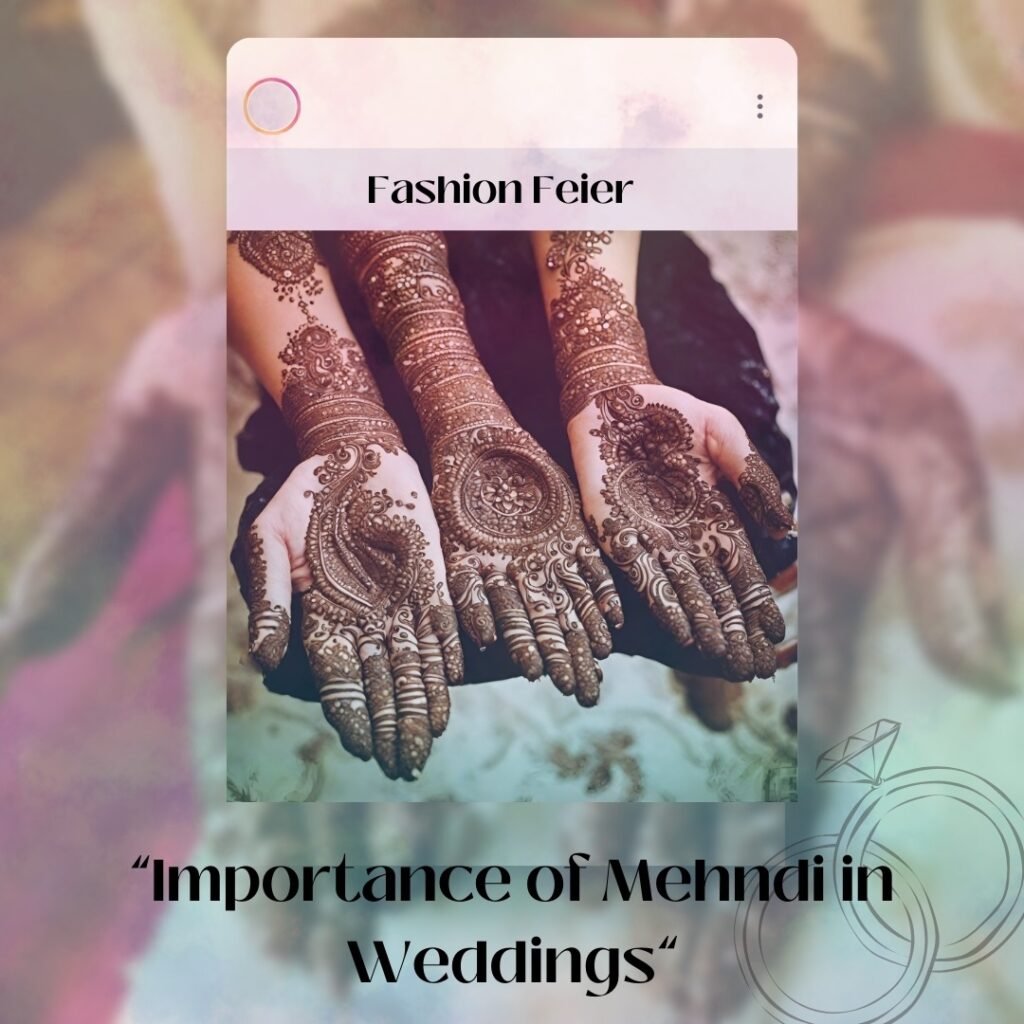Importance of Mehndi in Weddings: Explore Now
At Fashion Feier, we understand that weddings are not just about exchanging vows, they are a celebration of love, culture, and tradition. One such tradition that holds immense importance in weddings is the art of mehndi. Mehndi, also known as henna, is more than just a decorative element, it symbolizes the rich cultural heritage and traditions that define wedding ceremonies around the world. In this blog post Importance of Mehndi in Weddings, we delve into the Importance of Mehndi in Weddings, exploring its cultural roots, aesthetic beauty, and profound symbolism.
As a cornerstone of bridal adornment, the Importance of Mehndi in Wedding plays a vital role in enhancing the beauty and elegance of the bride. The intricate designs and patterns of mehndi not only adorn the bride’s hands and feet but also serve as a reflection of her personality and style. Mehndi ceremonies, often held in the days leading up to the wedding, are a time for celebration and bonding among family and friends. Through the application of mehndi, brides honor their cultural heritage and embark on their marital journey with blessings of love and prosperity.
Join Us as We Unravel the Importance of Mehndi in Weddings

Cultural Legacy: Mehndi is a representation of cultural identity and legacy that is intricately woven into South Asian wedding traditions. Applying mehndi is a beloved custom that has been passed down through the years and unites families in celebration. The Importance of Mehndi in Weddings is because of its elaborate designs and patterns, which capture the distinctive customs and beliefs of various regions.
Symbol of Celebration: Mehndi is a representation of cultural identity and legacy that is intricately woven into South Asian wedding traditions. Applying mehndi is a beloved custom that has been passed down through the years and unites families in celebration. The Importance of Mehndi in Weddings is because of its elaborate designs and patterns, which capture the distinctive customs and beliefs of various regions.
Blessings and Protection: The application of mehndi is said to bestow blessings and protection upon the bride in numerous cultures. The elaborate patterns are believed to ward off bad spirits and bestow wealth and luck upon the newlyweds. Intricate designs of mehndi are frequently put on a bride’s hands and feet as a sign of fertility, well-being, and marital bliss.
Bridal Tradition: The bride’s mehndi is a very important component of her bridal ornamentation and has a specific meaning for her. Mehndi accentuates the bride’s natural beauty and lends her bridal attire a hint of refinement. The elaborate patterns highlight the bride’s hands and feet as she sets off on her journey into married life and represents love, beauty, and elegance.
Expression of Creativity: The elaborate designs and patterns used in mehndi art are a means for artists to display their talent and workmanship. The Importance of Mehndi in Weddings offers countless opportunities for artistic expression, ranging from classic themes to modern styles, enabling brides to customize their Mehndi designs to represent their unique preferences and likes.
Bonding Experience: Mehndi ceremonies serve as a bonding event for the bride and her female relatives and friends, in addition to being an occasion for the application of henna. As part of the long-standing custom of applying mehndi to the bride’s hands and feet, mehndi rituals offer women a private space to connect, laugh, tell stories, and make treasured memories.
Importance of Mehndi in Wedding: Final Words for it
We see a reflection of the complex web of human emotions that are entwined during weddings in the elaborate mehndi designs. The bride can convey her love, joy, and anticipation through the vivid hues adorning her feet and the delicate strokes adorning her hands, all through the art of mehndi. The Importance of Mehndi in Wedding rituals cannot be emphasized since it represents the cultural legacy and customs that unite families and communities in addition to the bride’s attractiveness.
Beyond its aesthetic value, the Importance of Mehndi in Weddings has great cultural and spiritual significance. Mehndi ceremonies create a link between generations by enacting customs and rituals that are shared between them. Brides respect their cultural heritage and uphold the ageless traditions that have been handed down through the ages as they adorn themselves with mehndi. Mehndi becomes a palpable link to the customs and principles that shape our identities, transcending its role as merely a decorative accent.
The memory of Mehndi remains as a treasured keepsake of love and togetherness as we bid farewell to the celebrations and the sounds of laughter fade into the night. It serves as a reminder that, despite the hectic nature of wedding planning, the true meaning of marriage is found in the warmth of beloved customs and simple moments spent together. Beyond ethnic barriers, the Importance of Mehndi in Weddings is a worldwide symbol of love, joy, and tradition. It is a timeless illustration of the strength of love and the enduring ties that bind us all together.
FAQ About Importance of Mehndi in Weddings
Why is Mehndi used in weddings?
Customary Practice: The tradition of mehndi has been a part of numerous wedding rituals for a very long time. It represents the change from being single to becoming married. Blessings and Good Fortune: It is thought that a bride who wears mehndi will receive good fortune and fortune.
Why is Mehndi important in a wedding?
Mehndi is a representation of luck and good vibes. In Indian wedding tradition, the bride is wished good health and prosperity on her journey to marriage with a mehndi ritual the night before the wedding.
Is Mehndi necessary for a wedding?
The Mehndi application falls within the bride-to-be's solah sringar. For the groom, even a small hint of henna application is auspicious. It is observed in various regions of India as part of the wedding custom, as well as in the neighboring nations of Bangladesh, Nepal, and Pakistan.